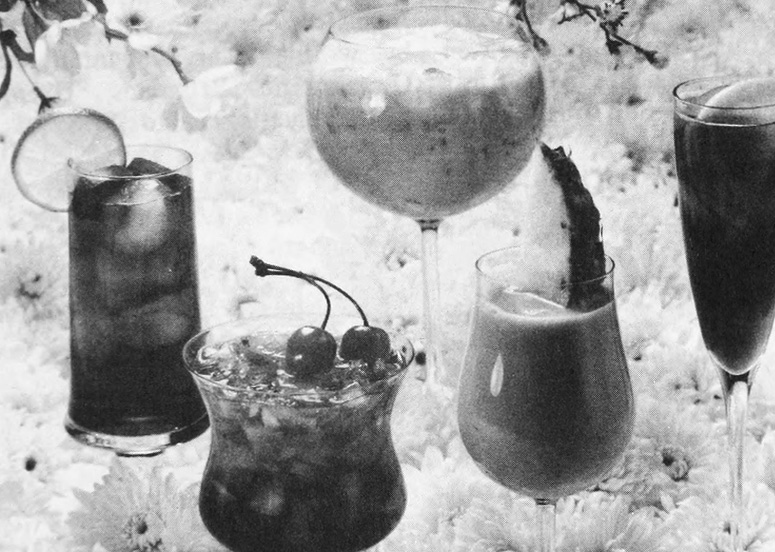I have a drinking problem, or so I am told. It’s not that I drink too early in the day or get stroppy or do things I regret the morning after. My problem, apparently, is that I don’t drink enough. You could say that alcohol and I got off to a bad start. I’ll spare you the details, other than to say I was fifteen and it involved five rye and Cokes in quick succession at a cousin’s engagement party. The hangover lasted about three years. What was a golden age of experimental drinking for my underage pals was a time of cowering abstinence for me. The sight, the smell, even the suggestion of alcohol could trigger the dry heaves.
This was awkward because I lived in a part of rural Ontario where drinking was almost a patriotic duty. There were high-minded exceptions, but for the most part, wherever you went, alcohol was never far behind. Fastball tournaments, community picnics, auction sales, and fall fairs were often cover for the real event taking place on the sidelines. The locals made moonshine in old whisky casks and downed it in frightful quantities at field parties in the summer. Cruising the back roads with a case of beer in defiance of the law and mortality was a time-honoured Saturday-night ritual. Eventually, I realized that if I was going to have any kind of social life, I had to at least pretend to be on board. I’d accept a stubby, then drift off into the bushes and secretly dump the offending contents. And I learned to keep a safe distance from alpha drinkers, for fear of being unmasked as a weakling or a traitor.
By my second year in university, the physical and psychological toxins of those early cocktails had worn off to the point where I was able to have a beer or a glass of wine and actually enjoy it. Note that I say a beer. I went to the purple Jesus parties and tequila sunrise all-nighters, but the intoxicant I abused typically came in Baggies and cost $20 an ounce. For this I earned a nickname: Half‑Miler.
Forty-five years later, I consider myself a regular drinker. Most nights, I pour a glass of wine or two with dinner. I love a cold beer on a warm summer day, the silky warmth of Irish whisky in the winter, or a tequila buzz anytime. But I still do not drink to get drunk. I still dread hangovers. I don’t care if others outpace me. I know my limit, and I stick to it. This has earned me another sobriquet: Mr. Moderation.

Mixology has continued unabated throughout the crisis.
From Cranberries magazine, 1936; Internet Archive
The sixteenth-century German Renaissance humanist and poet Vincent Obsopoeus seems to have been a man after my own heart. As rector of an elite high school in the Bavarian wine-growing region of Franconia, he was dismayed by an upsurge in binge drinking and the associated bad behaviour among local men, many of them knights with too much testosterone in their veins and too few crusades to fight. They consumed alcohol in staggering quantities: per capita consumption was six times higher than it is in Germany today (in 2016, the equivalent of 11.4 litres of pure alcohol). The wine allowance for patients in hospitals was 7 litres a day; the doctors who cared for them got the same. Obsopoeus endeavoured to set things right by composing an epic poem in Latin that he hoped would provide the framework for a healthier approach to imbibing. No teetotaller himself, Obsopoeus believed the secret was not abstinence but self-control.
Modelling The Art of Drinking on Ovid’s The Art of Love, Obsopoeus published a first version of the poem in 1536, when he was in his mid-thirties, and a longer edition a year later. The English version that Princeton University Press has published as part of its Ancient Wisdom for Modern Readers series is only the third translation of the poem in nearly five centuries.
The translator, Michael Fontaine, seems like a guy who’d enjoy a pint or two. A professor at Cornell University, Fontaine is an iconoclast on a mission to raise Latin from the dead. The more offbeat the subject matter, the better. His previous book was a translation of Pugna porcorum (The Pig War), a 248-verse satirical poem first published in 1530, in which every word begins with the letter P. (He even listed his surname as “Phontaine” on the title page.) The effort wasn’t all tongue-in-cheek: Fontaine believes the poem, about inequality among pigs, was an inspiration for George Orwell’s Animal Farm. He supplements his scholarly pursuits by moonlighting as a Latin whiz-for-hire, listing museums, antiquities dealers, and collectors among his clients. His eye for authenticity helped him expose forgeries in Renaissance and Dutch Golden Age paintings. He’s also Psychology Today ’s “Ancient Insights” columnist. (He recently assured readers who were housebound due to the coronavirus that it was perfectly fine to imbibe while isolated, citing no less an authority than Vincent Obsopoeus himself, who believed there’s no place like home for getting a little tipsy.)
With How to Drink, Fontaine parallels the wasted knights of Obsopoeus’s day with the excesses of modern bro culture, and he tailors the translation accordingly. He approaches Renaissance Latin not as a fortress but as a portal, listening for echoes of modern vernacular to give the 500-year-old verses a bracing shot of oxygen. In the introduction, he writes, “My aim was to transmute Obsopoeus’ thought and spirit into clear and idiomatic English as it is spoken in the United States today, especially as I hear it spoken on college campuses.” Personally, I know precious little about Latin, but I suspect Fontaine’s translation will have hidebound classicists squirming in their tweeds. The text brims with terms like “get hammered,” “hooking up,” “blowhards,” “college kids,” “jerk,” “snotty,” “sloshed,” “belching,” “farting,” and “barf.”
Endeavouring to systematize “the forms and norms of imbibing,” Obsopoeus divided his poem into three parts: “The Art of Drinking, Sustainably and with Discrimination,” “Excessive Drinking, What It Looks Like,” and “How to Win at Drinking Games.” While the translation offers a reprieve from the starchy conventions of Latin 101, what the verses actually say may put off modern readers who expect a degree of equanimity in literature and life in general. The poet is profoundly judgmental, not just about drinking but about everything from marriage and ex‑monks to gossips. I couldn’t shake an image of Obsopoeus holding forth in the sixteenth-century equivalent of Tim Hortons: you name it, he’s the guy with an opinion.
I was tempted to dismiss Obsopoeus as a prig. Then I remembered news reports about thousands of spring-breakers carousing in Florida while the rest of the world cowered under the onslaught of COVID‑19. Through my disbelief and rage, I realized Fontaine’s translation had nailed it: the sozzled brats in Daytona Beach and the debauched knights of Obsopoeus’s day share a moral vacuity. Their urge to get blotto prevails over reason. The poet’s indignation is just as valid today as it was then. I could picture the old boy patrolling the beach on a Segway, intoning, “Moderation must forever be your guiding principle.”
And to that I can only say: Amen, brother.
The immoderation that haunted my youth was typically Canadian. According to the World Health Organization, our per capita consumption of alcohol places us in the top 20 percent of imbibing nations (less than Germany’s but still the equivalent of 10 litres of pure alcohol a year). We drink less than our forebears in the United Kingdom and France, but more than our hulking cousin to the south (or any of our neighbours in the western hemisphere, for that matter). While the pandemic has shuttered vast swaths of the Canadian economy, alcohol sales continue unabated — deemed essential. With about one-fifth of the population considered to be heavy drinkers, public health researchers openly worry about forcing the nation to quit cold turkey.
Alcohol is, of course, big business. Titans like John Molson, Hiram Walker, and Samuel Bronfman helped to whet Canada’s thirst, then earned their fortunes delivering the stuff to slake it. More recently, regulatory changes and the ascent of the drink-local movement have triggered a rush of entrepreneurs staking out a claim in the country’s $30-billion-a-year market for alcoholic beverages.
Toronto tipple writers Stephen Beaumont and Christine Sismondo saw a story in the surge of artisanal and small-batch distilleries sprouting up in almost every region of the country. “It wasn’t too long ago that, in the eyes of most of the world, Canadian distilling was, to be quite honest, a bit of a joke.” But then something changed. From when Beaumont and Sismondo decided to write a book in 2018 to when they actually put their pens to paper, the number of small-scale distillers had grown by at least fifty. And the cohort would continue to be a moving target as their project neared completion.
Beaumont and Sismondo profile more than 160 distillers, from such giants as Crown Royal and Hiram Walker to staunchly local operations, with limited-batch spirits that run the gamut from premium whiskies to oddities such as bacon vodka and mushroom gin. “With devastatingly high shipping costs, it only makes sense to make the most of what you’ve got,” they write of the St. Lawrence Valley, “which has led to a region rich in esoteric gins made with seaweed, wild mushrooms, and a wide range of botanicals foraged from the boreal forest.” The book’s thumbnail sketches of these operations across the country are really the stories of the people who pour their hearts, souls, and sweat into their products. Common threads link them all: they tend to be young, risk takers, and passionate about producing spirits with character.
Canadian Spirits was slated to launch this past spring at BC Distilled, the country’s largest festival for artisan distillers. Like so many other things, the festival fell victim to the coronavirus. The moving target that challenged the authors while they were writing the book veered in the opposite direction not long after it was published. To get an idea of how the industry was weathering the crisis, I called Alex Hamer of Artisan Distillers Canada. He conceded it was hurting and that an unknown number of operations profiled in Beaumont and Sismondo’s book would likely fail in concert with the bars and restaurants that buy much of what they produce. (He also noted that scores of small-batch distillers had turned to making alcohol-based hand sanitizer.)
Canadian Spirits is thoroughly researched, attractively presented, and fun to read. It’s clear that for the majority of artisanal distillers, crafting spirits is a labour of love. But in the long run, the book’s most enduring merit may be as a snapshot of the country’s imbibing culture before the coronavirus put everything in a chokehold. In that sense, it’s not unlike The Art of Drinking, which evokes the tippling landscape of sixteenth-century Germany.
Like everyone else, I miss normal, even if normal implies a drinking culture that consigns me to its fringes. I would welcome the ragging of my pals if it meant we could be socially proximate again. If I could buy a couple bottles of wine without fearing for my life, I’d gladly pay for the experience with a hangover.
When the day of deliverance finally comes, I expect the country to go on a well-deserved bender. The words of Vincent Obsopoeus, echoing down the centuries, will never ring truer: “Let mugs brim with the juice of Your nectar; let Franconian wines flow in a never-ending stream!” I certainly intend to be part of the rejoicing, drink in hand. Maybe even two.
David Wilson bought his first car, a 1965 Plymouth Valiant, for $75 in 1980.

